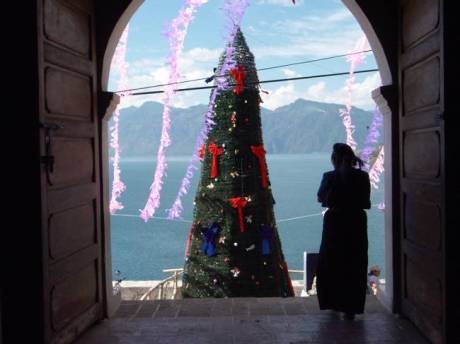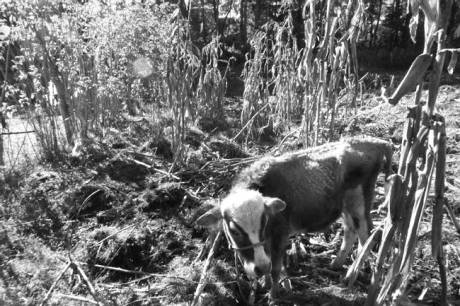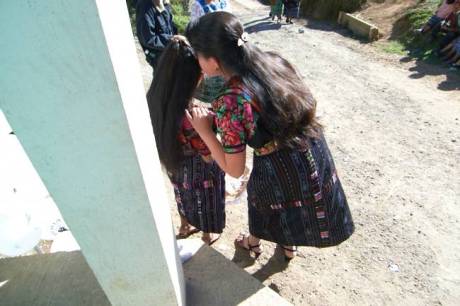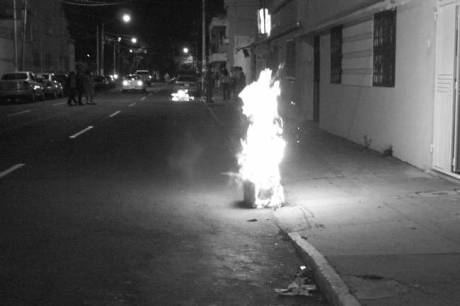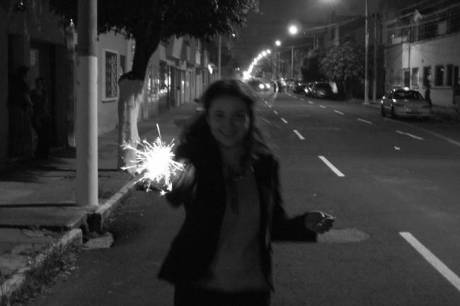Happy Holidays!
December 23, 2009
Happy Holidays dear readers! I am back in the USA for 12 glorious days, and enjoying a much-needed dose of English-language immersion. I had intended to add a new post today, but I’ve spent the last hour and a half catching up on Design Sponge instead of working. I guess it’s time to read the writing on the wall and go wrap presents. I’ll be back next week. Merry Christmas!
A Wedding in the Mountains and a Trip to the Lake
December 19, 2009
I like weddings way more than any self-professed feminist really should. I like weddings so much that when I was invited to a traditional Guatemalan wedding in a village 12 hours by bus from Guatemala City in the middle of the highest mountains in Central America, I still said yes. I spent the second half of the trip in a chicken bus, sharing a seat with three other people, but it was worth it. Bonus: After 12 hours on Guatemalan buses, I will never complain about the “indignities” of air travel ever again.
My office closed for the holidays last Friday, so I headed to Lago de Atitlan post-wedding to recover. My guidebook tells me that Aldous Huxley called it “the most beautiful lake in the world.” Someday, Rough Guide will have to add a paragraph noting that Emma Hulse agreed.

The morning of the wedding, the entire extended family arrived to help. These women made tamales from 9 AM until 2 PM.

The entire wedding, from the legal ceremony to the late-night dancing, took place in the family's home. There were 300 guests.
Nuts and Bolts or What I do when I am not writing this blog
December 16, 2009
Dear reader, you are truly blessed with patience. For almost 10 weeks, I´ve gone on about language anxiety and burning piñatas, American education reform and Guatemala City traffic, with only passing allusions to this supposed research that your hard-earned tax dollars are funding. Rest assured, I have not simply been hanging out, reading Freire and snapping photos. I have, in fact, been working, and the time has come to tell you about it.
I my second blog post, I told you the story of the women of Zoatecpan, who wanted to learn to read the Nahuatl alphabet but lacked teacher. What I didn´t tell you is that when Doña E told me she didn´t know how to read, I was in the midst of a bold, brave attempt to read Freire during our afternoon siestas. (Freire reading hint: do not attempt to read Pedagogy of the Oppressed after eating, on average, six to eight tortillas, echan de manos, and a bowl of black of beans. Yes, I know, that´s a lot of food, but have you ever eaten a tortilla made from corn grown 10 feet from where you are standing? Do you have any idea how good they are?) But even through my tortilla induced haze, I managed to make the connection: could Freire´s theories be used to construct a bilingual literacy program? If so, how?
I didn´t decide to apply to Guatemala until the next spring, when I had begun to work on my Fulbright application in earnest. I wish I could say I´d planned it, but the truth is that my choice was less stroke of genius than happy accident, the result of a brief encounter with Greg Grandin´s The Last Colonial Massacre (Thank you Nara!) and my lovely and amazing friend F´s account of her five-day Guatemalan sojourn. (There should probably be a plaque in the Swarthmore cafeteria.)
Happily for my research proposal, Guatemala turns out to be the perfect place to delve into the question. The illiteracy rate is the second highest in Latin America: only Haiti can best Guatemala´s rate of over 30 percent. Indigenous women are much less likely to know how to read and write than their male counterparts, and in some municipalities as many as 65 to 70% of indigenous women are illiterate. (There is frequently a disparity of 20 to 30% between indigenous men and women.) In a country where 23 indigenous languages are spoken, an even smaller number of indigenous women are likely to speak Spanish and their mother tongue with equal fluency. Given the magnitude of the problem, it is unsurprising that the implementation of bilingual, intercultural education programs in public schools was one indigenous demand codified in the 1996 Peace Accords, which ended the civil war.
What I proposed in my application, then, was to research how indigenous rights activists have interpreted and applied Freire´s theories to create literacy programs for adult, indigenous women, focusing on questions of gender and identity. How do they define popular education, and how does this definition translate into curriculum? I added the obligatory Rigoberta Menchu quote, and wrote a conclusion linking the project to my academic work on women´s citizenship, and Voila! A Fulbright application was born.
(It wasn´t really that easy, as those of you who were in my general vicinity in August and September of 2008 know, but let´s not dwell on that.)
Clever reader that you are, you might be wondering just what I plan to do with all this interpreting of Freire and ruminating on indigenous identity, besides write thrilling (yes?) weekly blog entries. What a good question! The truth is that I never intended to set out, digital recorder in hand, to put my pretty-little-white-girl-head to the task of theorizing indigenous identity. I was always much more interested in translating Freire´s theory into practice: in figuring out how a teacher could actually use Freire on a daily basis in a real classroom. So a practical project, rather than a published academic paper, became my goal. Generally, practical projects are much more useful when conceived and executed within institutions, so I figured I´d find an NGO that offered these fabled bilingual programs and convince them to let me hang out with them, making myself as useful as possible, until I decided what a practical project might actually look like.
I´ll spare you the long, tearful story of how it actually happened, (suffice it to say that involved much white girl angst, sending of emails, and Spanish phone scripts) but thankfully I found just such an organization willing to let me make myself useful. They don´t know I have this blog, and I´d like to write freely about their work without worrying that it will come up in a Google search, so I will refer to them here as P. P is large as NGOs go, comprised of a dozen distinct but interrelated projects that address a range of challenges facing indigenous communities but pay particular attention to education reform and community organization. It was founded exactly 20 years ago, after the worst years of the violence and just as an indigenous rights movement distinct from the leftist guerrilla began to emerge. As such, P´s organizational goals make heavy use of the language of human rights and the values of indigenous culture to demand a more equitable, inclusive society. (But there are plenty of pictures of Che on the walls and copies of Reminiscences of the Cuban Revolutionary War tucked between the volumes of Freire, as well as several children of urban disappeared on staff, making clear that the contemporary indigenous movement has deep political roots.)
After three weeks, I´m immensely impressed by the dedication of their staff and the quality of their work. The project I work for is relatively new, and is designed to address educational disparities among indigenous women and youth. In cooperation with CONALFA, the government adult illiteracy initiative, P has organized 20 new literacy groups in six departments, identifying municipalities with the highest rates of illiteracy. Approximately 400 women enrolled in the program, and roughly 70% completed the course. These women range in age from 15 to 70, and most are mothers or grandmothers. If they remain in the program for three years, they´ll receive certification for completion of primaria, the equivalent of elementary.
P recruited women from the communities to lead the literacy groups. Originally, they sought women with experiences in elementary education to serve as teachers, or facilitators, but in most communities staff were hard pressed to find any women who had completed the equivalent of middle school. So instead they identified women involved in community work, and trained them to implement the CONALFA curriculum. P is in the process of developing its own methodology, which should be implemented in the coming year of classes. This process of curriculum development and capacity building is what interests me most about P´s work, and I´m starting to conceptualize a project that would speak to my interest in the practice of popular education but also provide concrete assistance to facilitators. Until I get it worked out, I´ll be going to their office three or four days a week to listen, learn and make myself as useful as possible.
More later, probably Friday, possibly sooner. There will be pictures.
Quema del Diablo
December 8, 2009
 Living in Guatemala is an emotional roller coaster. Last night, I looked out the window of my cab at the sun setting over the Pacaya volcano and felt blessed. I had just attended a Mayan ceremony held in the pine forest on the campus of my new workplace. The “hacerdotes” poured sugar in a thin line on the earth, forming the shape of the flower, then filled the space with offerings of candles and chocolate, pine needles and flower petals, fruit and honey, all carefully arranged to preserve the balance of energy central to Mayan spirituality. They distributed fruit and white and yellow candles, and instructed us to place the white candles to the North, the yellow to the south, and to cluster the fruit at all four directional points. They built a cone out of pineapple trimmings and set the offering alight. As the flames licked upward, the hacerdotes led a series of prayers, turning to each of the directions, beginning with the east, associated with the rising sun and the color red, to the west, purple, symbolic of the “sun’s fall,” the south, yellow, symbolizing water, and the north, white, the direction of air and ancestors. As I watched the fire consume the petals and the wax, I understood how color can be seen as sacred, how ritual can cleanse. I was sure I was meant to come to Guatemala.
Living in Guatemala is an emotional roller coaster. Last night, I looked out the window of my cab at the sun setting over the Pacaya volcano and felt blessed. I had just attended a Mayan ceremony held in the pine forest on the campus of my new workplace. The “hacerdotes” poured sugar in a thin line on the earth, forming the shape of the flower, then filled the space with offerings of candles and chocolate, pine needles and flower petals, fruit and honey, all carefully arranged to preserve the balance of energy central to Mayan spirituality. They distributed fruit and white and yellow candles, and instructed us to place the white candles to the North, the yellow to the south, and to cluster the fruit at all four directional points. They built a cone out of pineapple trimmings and set the offering alight. As the flames licked upward, the hacerdotes led a series of prayers, turning to each of the directions, beginning with the east, associated with the rising sun and the color red, to the west, purple, symbolic of the “sun’s fall,” the south, yellow, symbolizing water, and the north, white, the direction of air and ancestors. As I watched the fire consume the petals and the wax, I understood how color can be seen as sacred, how ritual can cleanse. I was sure I was meant to come to Guatemala.
Tonight, I want to go home and drink non-instant coffee and eat salads and flush my toilet paper down the toilet and not to stare violence and poverty and desperation in the face every time I leave the house. This morning’s newspapers were splashed with images of police trucks burning in a town in the department of Sololá, where yesterday morning a man suspected of stealing cloth from the market was lynched. This is the third lynching in the Guatemalan highlands in a week and a half. Lynching here is a form of vigilantism, a public display of the anger at the ongoing decline of the security situation. But still, its hard to understand the sheer ferocity and brutality of these attacks. Victims are beaten or burned to death: three women who were captured with the thief barely escaped the flames that engulfed the police pickups.
It was an inauspicious start to the day known as “Quema del Diablo,” or “the Burning of the Devil.” At precisely 6:00, children and their parents enter the streets, armed with fireworks and devil piñatas. The piñatas are torched, the fireworks exploded. It’s like Fourth of July, except infused with the kind of transgressive euphoria normally associated with trick-or-treating, as adults and children savor the usually forbidden pleasure of Guatemala City’s night-time streets. Someone told me that the fires were meant to purify the streets for the processions of December 8, when some communities celebrate the feast of the Virgin of the Conception. How devil piñatas were first introduced was not entirely clear. Maybe it’s originally a Spanish tradition? All I know is that I would have enjoyed the whole thing more if I hadn’t woken up to read the story of the death of a man who may or may not have been a a thief and a devil: a man who was burned in a beautiful town in a small country that resembles nothing so much as a fallen Eden.
Pedagogy of the Oppressed 101
December 5, 2009
“This volume will probably arouse negative reactions in a number of readers. Some will regard my position vis-á-vis the problem of human liberation as purely idealistic, or may ever consider discussions of ontological vocation, love, dialogue, hope, humility, and sympathy as so much reactionary “blah.” Others will not (or will not wish to) accept my denunciation of a state of oppression that gratifies the oppressors. Accordingly, this admittedly tentative work is for radicals. I am certain that Christians and Marxists, though they may disagree with me in part or in whole, will continue reading to the end.”
– Freire Pedagogy of the Oppressed
“This, then, is the great humanistic and historical task of the oppressed: to liberate themselves and their oppressors as well.” So begins Pedagogy of the Oppressed, the Brazilian teacher and theorist Paulo Freire’s most famous work. Freire is the Che Guevara of education: his writings capture the sense of desperate urgency and forceful idealism that defined a pivotal moment in recent Latin American history, a moment subsequently swept away by a wave of continental, counter-revolutionary violence. But Freire remains a giant of the Latin American left, one of the few who still guides the work of educators and activists. Indeed, his theories are more than a new model of education and revolutionized definition of teaching; Freire represents a critique of the social order, a vision of political change and a theory of individual development. Freire is also half the reason I’m in Guatemala.
Published first in Portuguese in 1968, Pedagogy of the Oppressed is best understood not as a precise pedagogy but rather as a set of guiding principles for educators derived from Freire’s own experience leading basic literacy classes for peasants in Brazil and Chile. These “guiding principles” are now referred to as “critical pedagogy” or “popular education. Critical pedagogy (as formulated by Freire) rests on a fundamental assumption about relations of power: the world can be divided between the oppressors and the oppressed, both of whom are dehumanized as they, in turn, wield and submit to power. Freire argues that neither is free, that the existing social system stunts the growth of both, preventing them from undertaking the “indispensable … quest for human completion.” However, it is the oppressed who suffer the most, as their identity is submerged in that of their oppressors, rendering them “objects” incapable of recognizing the reality of their own condition. As extensions of a dominant will, they are at once themselves and their oppressors: they both desire freedom and fear it. This “fear of freedom” is the force that enables the continuation of conditions of inequality. It follows that universal freedom will only be achieved when the oppressed seek to free themselves, recognizing their true identity as subjects as they “perceive the reality of oppression not as a closed world from which there is no exit, but as a limiting situation which they can transform.”
There is nothing original about the dialectic proposed by Freire (see Hegel, Marx, Gramsci, Cesaire, Fanon, pretty much every Black radical who was alive in the 1960s, so on and so forth.) But while Marx argued for the necessity of change in the material basis of production and Fanon saw violence as the key to ending the colonizer’s psychological control, Freire points to education. The solution, he writes, is for the oppressed subject to “objectify” her reality, developing the language necessary to name her oppressor.
Freire is at once a critique of radicals who “sloganize” and teachers who “bank.” In the “banking model,” Freire writes, “education thus becomes an act of depositing, in which the students are the depositories and the teacher is the depositor.” The teachers narrate their knowledge, which the students are expected to hear, memorize, and repeat. Like the oppressed, students become simple extensions of their teacher’s intellect: “words are emptied of their concreteness and become hollow, alienated and alienating verbosity.” This kind of education presents reality as static, something to be observed and preserved. Just as students mindlessly memorize and repeat narrated “knowledge,” so the banking model teaches that people do not make their world and that they are powerless to change it. Submerged in such a vision of reality, we perpetuate oppression.
Real knowledge, real humanity and real freedom are then linked. “Knowledge,” Freire argues, “emerges only through invention and reinvention, through the restless, impatient, continuing, hopeful inquiry human beings pursue in the world, with the world, and with each other.” Education must be carried out through dialogue, not narrative: teachers should not deposit and student should not be depositories. Rather, they must engage with each other’s experience of reality, questioning their assumptions, identifying the forces that restrict them, and re-envisioning the world. As they name their reality, both teachers and students emerge as free subjects, conscious of both how the social order shapes experience and how the social order is shaped. They no longer see themselves as powerless objects of power, but as actors capable of making change just as they make words and sentences. For Freire, education is the practice of freedom.
In the second part of Pedagogy of the Oppressed, Freire begins to lay out how such a practice should be carried out. It is essential that all educational programs begin from the student’s own experiences, a principle that somewhat explains Freire’s lack of specificity about the methodology of popular education. Educators, he explains, should work with members of the community in which they plan to work to choose curriculum content. He proposes a model of “culture circles,” consisting of stages of problem posing, discussion and investigation. The teaching of literacy should begin with whole words, so that students always understand the link between the word and the world, the meanings of language and our understanding of reality.
These words should evoke generative themes words chosen to provoke discussion and to force both students and teachers to articulate their understanding of reality. In Brazil, Freire used pictures of favelas, or slums, and the world “favela” itself, in his “culture circles.” In Chile, he mentions drawings of an alcoholic man returning home past young man on a street corner, which Freire refers to as a “codifications.” Participants commented that “the only one there who is productive and useful to his country is the souse who is returning home after working all day for low wages and who is worried about his family because he can’t take care of their needs. He is the only worker. He is a decent worker and a souse like us.” “There are two important aspects to these declarations,” Freire continues. “On the one hand, they verbalize the connection between earning low wages, feeling exploited, and getting drunk- getting drunk as a flight from reality, as an attempt to overcome the frustration of inaction, as an ultimately self-destructive solution. On the other hand, they manifest the need to rate the drunkard highly. He is the “only one useful to his country, because he works, while the others only gab.” After praising the drunkard, the participants then identify themselves with him, as workers who also drink- “decent workers.”
The final chapter of Pedagogy of the Oppressed links education with broader social movements, emphasizing the necessity of working from within oppressed communities. Critical pedagogy, Freire argues, must serve as the model for all revolutionary action. But this extrapolation of the practice of the classroom to the political arena is where the gaps and ambiguities in Freire’s theories begin to show. What exactly is the expected outcome of a program of popular education? He argues forcefully against materialism, asserting that psychological liberation and human action is essential to social change, yet also hints at the necessity of organization and even fleetingly defends political violence. He insists on the necessity of mutual reflection in educational exchange, as both teacher and student reconsider their understanding of reality, yet clearly believes that Marxism is the best analytical framework for explaining reality. Freire is both a liberal and a Marxist, and as such illustrates the challenge of reconciling the two philosophies.
Freire, then, leaves us with both a compelling vision of liberatory education and a long list of open questions, some theoretical, some political, some practical. How is Freire applicable to the work of teachers: those who consider themselves radical but are neither guerillas nor organizers, who work within the confines of a classroom and the limits of present politics? How should it be used to guide daily decisions made about teaching, and how does it translate into classroom practice? How can educators borrow from Freire to address themes like race, gender and culture, themes Freire might not have disregarded but certainly would not have prioritized over class? These are the questions I proposed to explore in my Fulbright application, and that I return to continually as I begin my work in Guatemala.
* If you are interested in learning more about Freire (you should be) but don’t want to wade through 150 pages of pseudo-Hegelianism, I would highly recommend We Make the Road by Walking, a book-length interview of Freire and Myles Horton, the founder of the legendary Highlander Folk School. When Freire goes off on an extended tangent, Horton will usually come in with some kind of dry, funny anecdote about dirt farmers, which usually say everything Freire was trying to say, except in a paragraph or less. (I am naming my first-born son Myles Horton. I’m completely serious.)

